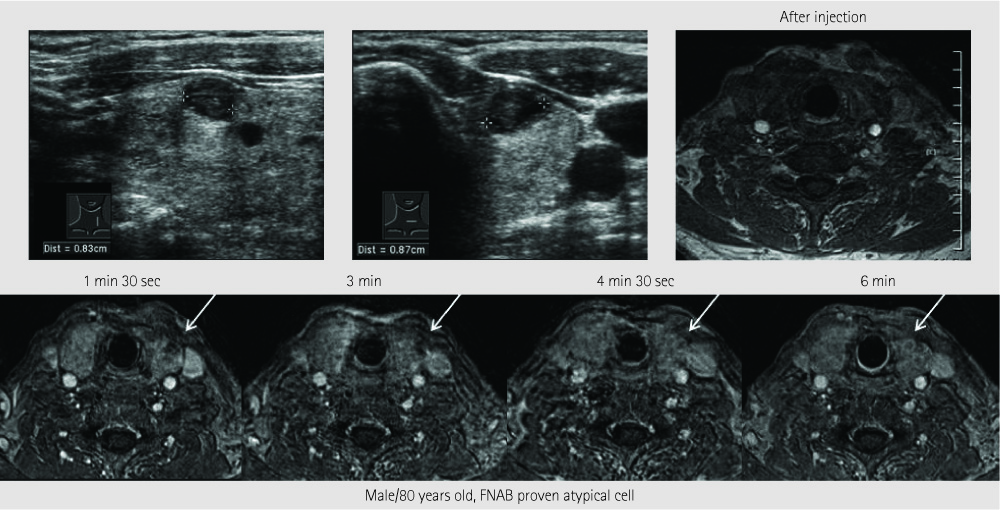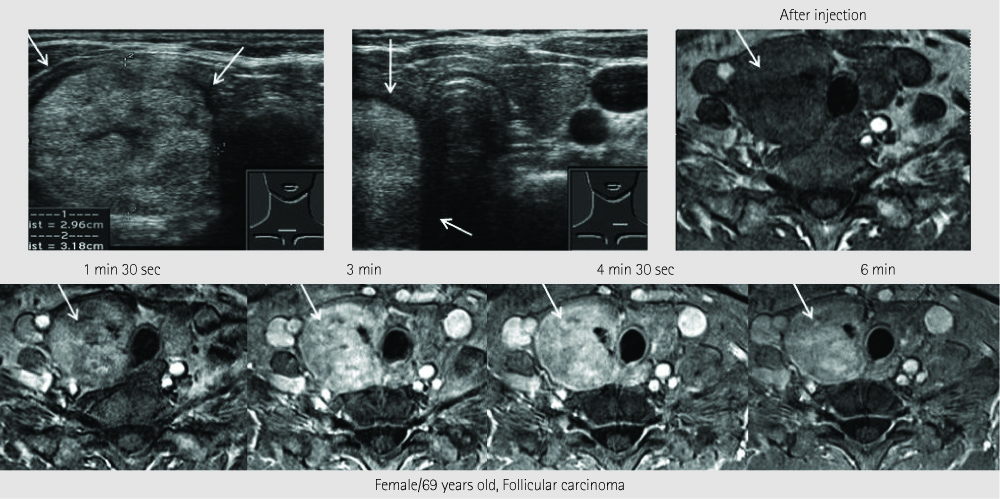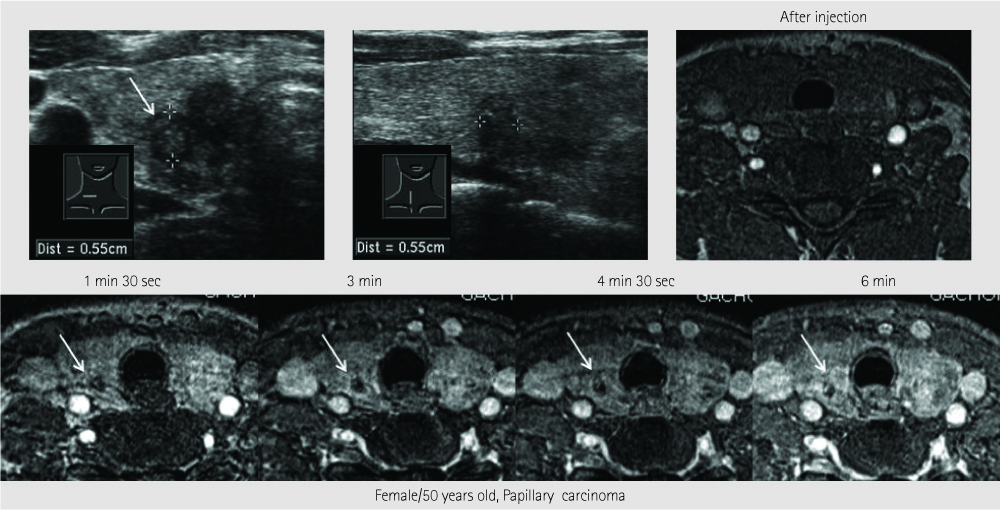J Korean Soc Radiol.
2011 Nov;65(5):433-439.
Characteristic Dynamic Enhancement Pattern of Magnetic Resonance Imaging for Malignant Thyroid Tumor: A Preliminary Report
- Affiliations
-
- 1Department of Radiology, Gil Hospital, Gachon University of Medicine and Science, Incheon, Korea. h2yrad@naver.com
Abstract
- PURPOSE
The purpose of this study is to determine the characteristic dynamic enhancement pattern of magnetic resonance (MR) imaging for malignant thyroid tumor.
MATERIALS AND METHODS
Eight patients who were pathology proven to have a malignant thyroid tumor, preoperatively. There are 5 papillary carcinomas, 1 medullary carcinoma, 1 follicular carcinoma, and 1 fine needle aspiration biopsy proven atypical cell.
RESULTS
Based on preoperative MR imaging, we compared the dynamic MR enhancement pattern relating to the pathologic type. On contrast agent-enhanced dynamic T1-weighted image (T1WI), 5 papillary carcinoma and one medullary carcinoma showed delayed enhancement compared to normal parenchyma. In addition, one follicular carcinoma shows stronger enhancement than normal parenchyma, with one papillary carcinoma showing a persistent decrease in enhancement compared to normal parenchyma.
CONCLUSION
Although this study is limited by a small patients population, the data suggests that delayed enhancement on enhanced dynamic T1WI is a possible characteristic MR finding of a malignant thyroid tumor. I think that the comparison of MR imaging between benign and malignant nodules is required for a correct characterization.
MeSH Terms
Figure
Reference
-
1. de la Torre NG, Buley I, Wass JA, Turner HE. Angiogenesis and lymphangiogenesis in thyroid proliferative lesions: relationship to type and tumour behaviour. Endocr Relat Cancer. 2006; 13:931–944.2. Jugenburg M, Kovacs K, Stefaneanu L, Scheithauer BW. Vasculature in nontumorous hypophyses, pituitary adenomas, and carcinomas: a quantitative morphologic study. Endocr Pathol. 1995; 6:115–124.3. Turner HE, Nagy Z, Gatter KC, Esiri MM, Harris AL, Wass JA. Angiogenesis in pituitary adenomas and the normal pituitary gland. J Clin Endocrinol Metab. 2000; 85:1159–1162.4. Niveiro M, Aranda FI, Peiró G, Alenda C, Picó A. Immunohistochemical analysis of tumor angiogenic factors in human pituitary adenomas. Hum Pathol. 2005; 36:1090–1095.5. Stark DD, Moss AA, Gamsu G, Clark OH, Gooding GA, Webb WR. Magnetic resonance imaging of the neck. Part II: pathologic findings. Radiology. 1984; 150:455–461.6. Higgins CB, McNamara MT, Fisher MR, Clark OH. MR imaging of the thyroid. AJR Am J Roentgenol. 1986; 147:1255–1261.7. Weidner N, Semple JP, Welch WR, Folkman J. Tumor angiogenesis and metastasis--correlation in invasive breast carcinoma. N Engl J Med. 1991; 324:1–8.8. Des Guetz G, Uzzan B, Nicolas P, Cucherat M, Morere JF, Benamouzig R, et al. Microvessel density and VEGF expression are prognostic factors in colorectal cancer Meta-analysis of the literature. Br J Cancer. 2006; 94:1823–1832.
- Full Text Links
- Actions
-
Cited
- CITED
-
- Close
- Share
- Similar articles
-
- Dynamic Contrast-Enhanced MR Imaging of Tietze’s Syndrome: a Case Report
- Dynamic MR Imaging of Hepatic Hemangioma and Hepatocellular: Findings and Differential Diagnosis
- Significance of Dynamic MRI in Brain Tumors
- Differential Diagnosis of Hepatic Malignant Tumors and Hemangiomas by Using Dynamic Magnetic Resonance Imaging
- Preliminary Experience Using Dynamic MRI at 3.0 Tesla for Evaluation of Soft Tissue Tumors




